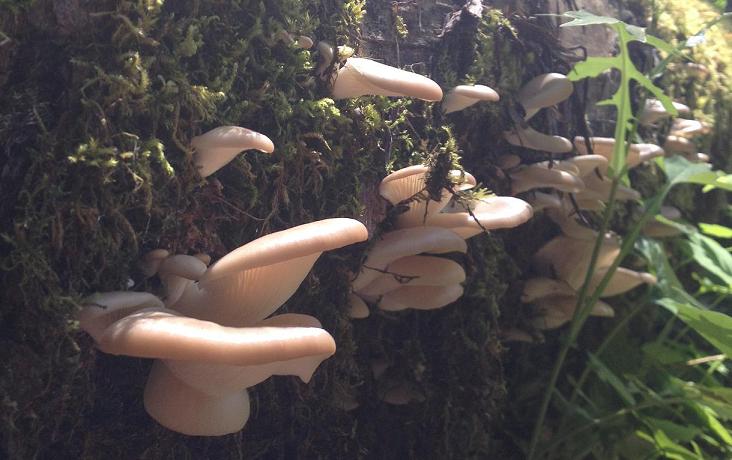 In the fertile forests surrounding Cumberland there is a special spot, just a couple ‘o yards from their famous mountain biking trails (hint: just across the bridge and to the left) that so many of us crankjobs fly past without a second glance. In this dank little oasis, tucked away under salal bushes is a rotten old alder tree (nearly 15 meters long and god knows how long dead) that houses a secret, edible ecosystem.
In the fertile forests surrounding Cumberland there is a special spot, just a couple ‘o yards from their famous mountain biking trails (hint: just across the bridge and to the left) that so many of us crankjobs fly past without a second glance. In this dank little oasis, tucked away under salal bushes is a rotten old alder tree (nearly 15 meters long and god knows how long dead) that houses a secret, edible ecosystem.
Twice a year (once in the spring and later on in the autumn) this fallen titan sprouts hundred upon hundreds of snow white fungal tongues that quickly grow into families of winged oyster mushrooms. When in full bloom the tree is nearly covered in fungus and can be spotted from much farther away… Luckily for me no one is venturing that far off the trails. These guys are all mine!
Oyster mushrooms (less often known as “abalone” or “tree” mushrooms) are one of the hardiest, widest spread and easily cultivatable types of edible fungus known to man. They’re a staple ingredient in most Asian and European cuisines and are most likely (if you are in the Western Americas) growing in your back yard right now.
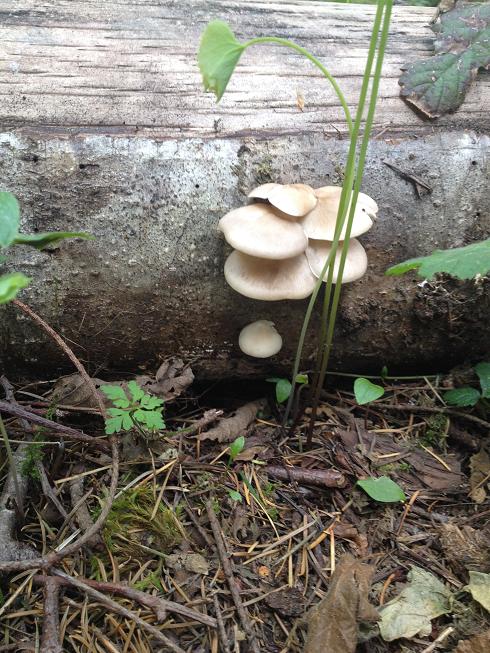 What You Will Need To Forage Oyster Mushrooms
What You Will Need To Forage Oyster Mushrooms
- A Winter Coat and Boots – It rains here on the West Coast… Like eight months of the year… If you don’t want soggy underbits you’ll be smart to leave the house with a hard shell and some serious slogs.
- Sharp Knife – For getting ‘shrooms off trees.
- Container and Paper Towels – Oyster mushrooms are slightly more delicate than your normal Westcoast fungus so a lightly wrapped and loosely packed Ziploc will keep your treasure from getting too smooshed on the way back home.
There are a couple ‘o varieties of oyster mushrooms that sprout out here, each with slightly different characteristics (usually just size and colour) but enough similarities to make identification pretty simple:
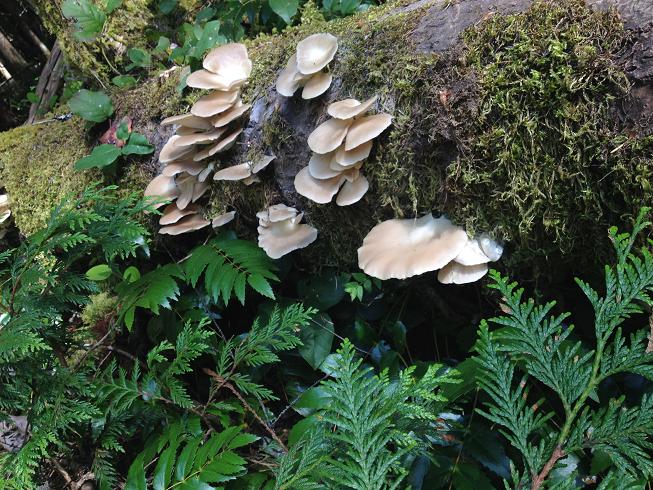 Habitat
Habitat
Oyster mushrooms are saprotrophic (there’s your word of the day) meaning they feed on rotting wood. They don’t pop up out of the ground or adhere themselves to rocks, just trees, both dead and nearly-dead. So if you find a mushroom that looks like an oyster but isn’t protruding from a stump, move along.
Appearance
Like actual oysters, these mushrooms come in a variety of colours from a peachy blush to a charcoal grey, but only it seems, on their caps. The stalk of an oyster mushroom is uniformly white with a series of parallel gills running all the way down the stem into the log.
They grow as a family, starting out as a mass of little nubs into a shelf-like protuberance of little tongues (or in the case of their equally-edible cousins; “angel wings”) sticking out and up from the log or stump. This stage, when the oyster still has a tight, convex cap is the best time to harvest ‘em.
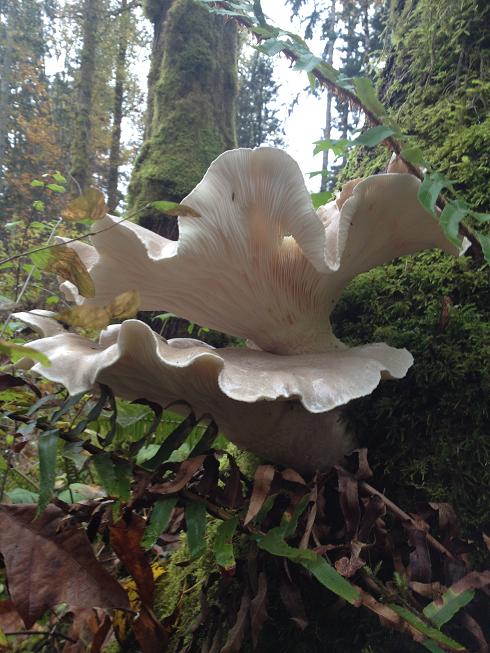 Older mushrooms have caps that sag inwards and develop a fluted edge that resembles the shells of their oceanic namesake. In some cases they can grow as large as hubcaps and will continue to extend their endlessly curling outer lip leading to some impressively mutated shapes. They are still technically edible at this stage, but who knows how many critters have made their home amongst all those wrinkles and folds.
Older mushrooms have caps that sag inwards and develop a fluted edge that resembles the shells of their oceanic namesake. In some cases they can grow as large as hubcaps and will continue to extend their endlessly curling outer lip leading to some impressively mutated shapes. They are still technically edible at this stage, but who knows how many critters have made their home amongst all those wrinkles and folds.
There are only a couple other mushrooms that resemble oysters: One is the angel wing mushroom that I’ve already mentioned, which is not only completely edible but even tastier than the oysters. The other is the “False” or “Late” Oyster Mushroom which resembles a real oyster but has yellowish gills and a hairy little stem. It’s not poisonous, but very bitter.
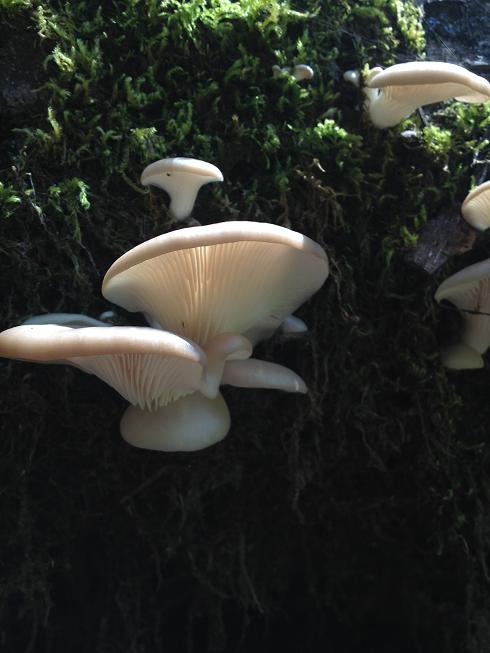 Harvesting
Harvesting
Aside from the dead of winter these fungal families can grow nearly all year long, so get out there and see what you can see. Harvesting ‘em is simple: just lay your knife flush against the tree and snip off the whole family. Don’t worry; they’ll be back in a couple ‘o months.
Aroma and Taste
Unlike actual oysters or their fellow fungi chanterelles or pine mushrooms, the aroma of young oyster ‘shrooms is very mild. Only slight hints of anise and almond are present in young shrooms, and they age they develop an even lighter, albeit mustier scent akin to sawdust. In either stage it’s pretty hard to sniff ‘em out in the wild.
They taste just as mild as they smell, with only the slightest hint of amaretto, apricot and maybe a bit of that aftertaste you get from Japanese dashi (a bit of seaweed maybe?) but without any substantial, overriding flavour. If it wasn’t for their chewy texture and ability to hold their shape during cooking there wouldn’t be much to talk about.
But mildness can be a good thing! So what if oyster mushrooms haven’t got much of a smell and half as much of a taste? They’re really good at sucking up other flavours, particularly fatty and oily ones. Chinese stir fry or a French duxelle are both classic preparations as they both involve lots of fat and high heat… Oyster mushrooms with oyster sauce you say?
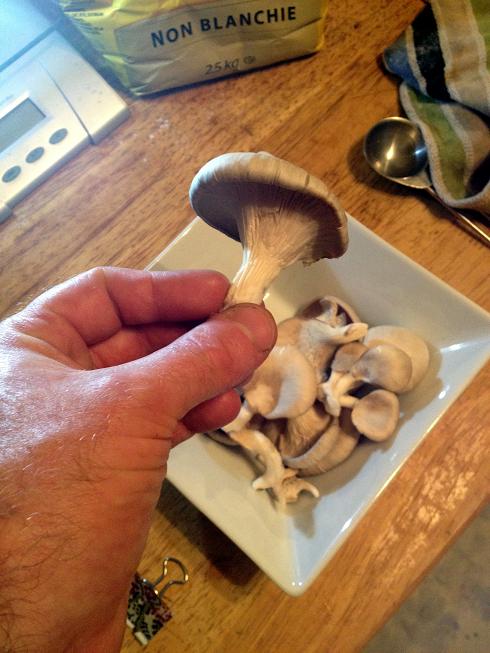 Cultivation
Cultivation
As I mentioned in my Gift Guide for Foragers you can buy “farms” of oyster mushrooms that you can grow ridiculously easy on your window sill. They’re basically just bricks of sawdust and coffee grounds filled with spores that will sprout a crop of ‘shrooms within a week of being watered.
If you’re into oldschool (and potentially more sustainable/lucrative) mushroom farming, then oyster ‘shrooms are your go-to crop. They grow like wildfire in hardwood stumps if kept out of direct sunlight and watered regularly. Kits are available through a number of Westcoast sources, or you can DIY a stump yourself with a little help from the fine folks at Instructables.
Whether you’re interested in studying, harvesting or growing these weird little fungus, it’s a great way to get in on the ground floor ‘o the mycelium scene. Even for idiots like me! Because of their resilience, deliciousness, ease of harvest and tendency to pop up in the most interesting, yet predictable of places they are a certified West Coast jem.
Still, stay away from my log in Cumberland.
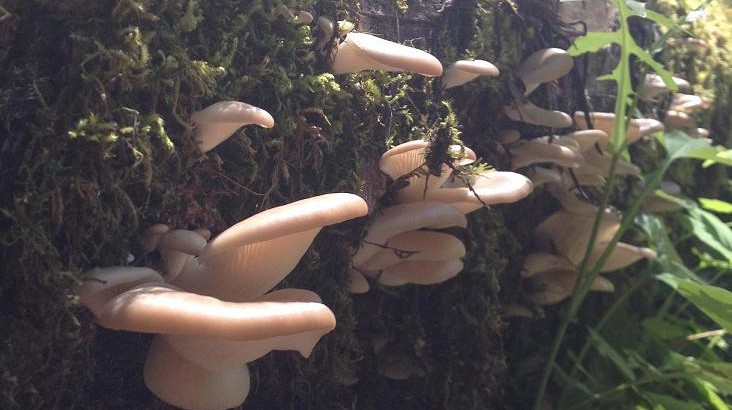
I did not realize how many edible mushrooms we have growing here on the island!
Have to try them.
Yeah, they’re delicious and pretty easy to find/identify. I’ll see if I can find some morels this spring as well!